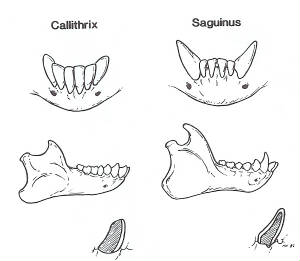|
Click here for genus info
The New World monkeys are anthropoids and differ from the prosimians in their jaw and teeth morphology. They have fused mandibular
symphysis, and upper molar hypocones. see image below.

Anthropoids all have two incisors. All have three molars except the tamarins and marmosets (they have two molars). They
also have reduced trigonids and broadened talonid basins. Most have no paraconids.
The platyrrhines (or New World monkeys) live in Central and South America. They have three premolars (unlike catarrhines).
Most have no hypoconulids on the first two lower molars.
Different genera of platyrrhines have different teeth morphologies due to different diets. (See illustration below).

Subfamily Pitheciines: The diet of this subfamily consists mainly of fruit and seeds with hard coverings. To bite through
such hard foodstuffs, these primates have unique teeth. The incisors and canines are large. The incisors are procumbent
and stick out. The premolars and molars are square in shape and have low cusps. Pitheciines also have a U-shaped palate
Subfamily Callicebinae: This group contains the Titi monkeys. They have short canine teeth and simple molars. There
is sexual dimorphism in the teeth of one species. Their diet tends to be primarily fruit.
Aotines: This group contains the owl monkey, which is the only nocturnal anthropoid. These primates have large upper
central incisors. They have small third molars as well. Owl monkeys have a diet mostly consisting of fruit, but will eat
leaves and insects as well.
Atelines: The dentition in this group varies among the different genera. One such genus is the howling monkey, or Alouatta.
This genus has sexually dimorphic canines, and small incisors. Their molars are designed to shear leaves and have high crests.
The lower molars have a narrow trigonid and large talonid. A distinguishing feature is the giant mandible (see photo of skull
on the "species" page). This helps in the complex used to make their titular "howling" sound. Spider
monkeys are a separate genus (Ateles). Spider monkeys have large incisors and small molars with low rounded cusps. They
feed primarily on fruit and baby leaves. Woolly spider monkeys differ from spider monkeys, having small canines and shearing
crests on the molars similar to the howler monkey.
Cebinae: This group contains the capuchins and squirrel monkeys. Capuchins (Cebus) are sexually dimorphic, have large
premolars, square molars, and thick enamel. They feed on hard nuts. The squirrel monkeys' (Saimiri)dentition is similar
to the capuchins. They have broad upper molars, a large lingual cingulum, and small molars (towards the back of the mouth).
The squirrel monkeys are also sexually dimorphic in their dentition, and they have sharp cusps on their molars and premolars
to eat a diet of insects. They also feed on fruit.
Callitrichines: This group contains the marmosets and tamarins. This group usually does not display sexual dimorphism.
Their dentition is unique in having three premolars and tritubercular upper molars with no hypocone. The dentition of
tamarins and marmosets differ. This can easily be seen in the illustration below (the marmoset is left and the tamarin is
right).

Information on this page was provided by Primate Adaptation and Evolution, Second Edition, by John G. Fleagle. (for more
information please see "sources" page)
|

